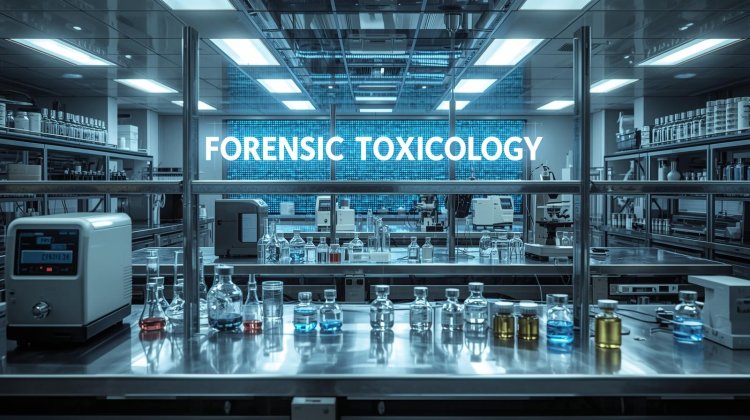Investigating the Future: Day 3 of International Forensic Science Week - Introduction to Forensic Toxicology
Toxicology is a branch of science or medicine which deals with properties, action, lethal dose, toxicity detection and elimination of poison and its sign, symptoms diagnosis treatment and autopsy finding of poisoning cases.

TOXICOLOGY - Ancient greek word
TOXICOSIS - Poisonous
Forensic Toxicology
Father of toxicology - Mathew orffila .It applies toxicology + analytical chemistry + law to investigate deaths, crimes, and poisoning cases.
Deals with the legal procedures, medical and legal procedures of death using drug or poison. Detecting, identifying, and interpreting poisons, drugs, alcohol, and other toxic chemicals in biological and non-biological materials for legal and medico-legal purposes is the focus of the forensic science field known as forensic toxicology.
Poison
Substance, liquid solid or gas, which when administered in small quantities into living body or brought into contact loads to injury or destruction of life by its action. Any substance that might cause illness, harm, or death through its chemical effect when ingested, inhaled, absorbed, or injected into the body is considered a poison.
Classification of Poisons Based on Physiological Action
1. Corrosive Poisons
Act locally and destroy tissues by chemical action.
-
Examples: Strong acids (H₂SO₄, HNO₃, HCl), Strong alkalis (NaOH, KOH), Carbolic acid (phenol).
2. Irritant Poisons
Cause irritation, inflammation, and gastroenteritis.
-
Examples
-
Inorganic: Arsenic, Mercury, Copper, Lead.
-
Organic: Castor oil seeds, Abrus precatorius (rosary pea).
-
Mechanical: Diamond dust, powdered glass.
-
3. Neurotic Poisons
Affect the nervous system.
-
Cerebral Poisons (narcotics, hypnotics, inebriants): Alcohol, Opium, Barbiturates, Cannabis.
-
Spinal Poisons: Strychnine (causes convulsions, muscle spasms).
-
Peripheral Nerve Poisons: Curare, Botulinum toxin, Organophosphates.
4. Cardiac Poisons
Act on the heart and circulation, causing arrhythmia or failure.
-
Examples: Digitalis, Oleander, Aconite, Tobacco (nicotine).
5. Asphyxiant Poisons
Interfere with respiration or oxygen utilization, leading to hypoxia.
-
Examples: Carbon monoxide, Carbon dioxide, Cyanide, Hydrogen sulphide, Chloroform.
6. Miscellaneous Poisons
Produce other systemic effects not falling strictly into the above groups.
-
Food Poisons: Clostridium botulinum, Salmonella.
-
Abortifacients: Ergot, Calotropis, Oleander, Quinine.
-
Stupefying Poisons: Dhatura, Cannabis (used to incapacitate victims).
Classification of Poisons Based on Chemical Action
1. Inorganic Poisons
Derived from minerals, metals, and non-metals.
-
Acids & Alkalis (Corrosives)
-
Acids → Sulphuric acid, Hydrochloric acid, Nitric acid
-
Alkalis → Sodium hydroxide, Potassium hydroxide, Ammonia
-
-
Metallic Poisons: Arsenic, Mercury, Lead, Copper, Zinc, Thallium
-
Non-Metallic Poisons: Phosphorus, Iodine, Bromine, Chlorine, Fluorine
-
Gaseous Poisons: Carbon monoxide, Carbon dioxide, Hydrogen sulphide, Phosgene, Cyanogen
2. Organic Poisons
Derived from plants, animals, or synthetic organic chemicals.
-
Vegetable Poisons (Alkaloids, Glycosides, Resins)
-
Alkaloids → Morphine, Atropine, Strychnine, Nicotine, Dhatura
-
Glycosides → Digitalis, Oleander
-
Resins → Croton oil, Cannabis
-
-
Animal Poisons: Snake venom, Scorpion sting, Cantharidin, Spider venom
-
Organic Chemicals & Drugs
-
Alcohols (Ethanol, Methanol)
-
Barbiturates, Benzodiazepines
-
Pesticides (Organophosphates, Carbamates, Organochlorines, Pyrethroids)
-
Volatile substances → Chloroform, Ether, Benzene, Acetone
-
Toxicological Poison Identification
I. Preliminary / General Tests (Screening)
Used to indicate the possible presence of poison in biological samples (stomach contents, urine, viscera).
-
Color Tests → Give characteristic color with specific reagents.
-
Precipitation Tests → Poisons form insoluble precipitates with reagents.
-
Crystalline Tests → Formation of identifiable crystals under microscope.
-
Chromatography → Separation of mixtures (TLC, Paper chromatography).
-
Spectroscopy (UV/IR) → Preliminary identification of functional groups.
II. Specific Chemical Tests for Inorganic Poisons
1. Arsenic (As)
-
Marsh Test → Formation of arsenic mirror/black deposit in tube.
-
Reinsch Test → Deposition of arsenic on copper strip → steel-grey film.
-
Gutzeit Test → Yellow to brown stain on mercuric chloride paper.
2. Mercury (Hg)
-
Reinsch Test → Silver/grey coating on copper strip.
-
Reduction Test → Mercury globules obtained on heating.
3. Lead (Pb)
-
H₂S Test → Black precipitate of PbS.
-
Potassium chromate test → Yellow PbCrO₄ precipitate.
4. Copper (Cu)
-
Ammonia test → Deep blue color with ammonia solution.
-
Potassium ferrocyanide test → Red-brown precipitate.
5. Phosphorus (P)
-
Garlic odor from stomach contents.
-
Silver nitrate test → Black precipitate.
-
Luminous test → Stomach contents glow in dark.
6. Cyanide (CN⁻)
-
Prussian Blue Test → Deep blue color.
-
Sodium picrate test → Brick red color.
-
Guaiacum test → Blue color with guaiacum and hydrogen peroxide.
III. Specific Tests for Organic Poisons
1. Alkaloids (Morphine, Atropine, Nicotine, Strychnine, etc.)
-
Dragendorff’s Test → Orange precipitate.
-
Mayer’s Test → Cream precipitate.
-
Wagner’s Test → Reddish-brown precipitate.
-
Hager’s Test → Yellow precipitate.
2. Barbiturates
-
Zwikker’s Test → Violet color with cobalt nitrate and pyridine.
-
Dille–Koppanyi Test → Violet color (screening for barbiturates).
3. Cannabis
-
Beam’s Test → Violet color with alcoholic KOH.
-
Duquenois–Levine Test → Violet color in chloroform layer.
4. Opium / Morphine
-
Froehde’s Test → Purple color.
-
Marquis Test → Violet color.
-
Mecke’s Test → Green color.
5. Cocaine
-
Cobalt thiocyanate test (Scott’s test) → Blue color turning pink with HCl.
6. Alcohol
-
Odor test → Smell in breath/stomach contents.
-
Oxidation (Chromic acid test) → Green color.
-
Enzyme method (ADH test) → Detects ethanol in blood.
-
Widmark’s method → Quantitative estimation.
IV. Instrumental Confirmatory Tests
-
Chromatography → TLC, HPLC, GC.
-
Spectroscopy → UV, IR, NMR.
-
GC-MS / LC-MS → Definitive identification & quantification.
-
AAS (Atomic Absorption Spectrophotometry) → Heavy metals (As, Pb, Hg, Cu).
-
ICP-MS → Trace element detection.
-
Immunoassays (ELISA, RIA) → Screening for drugs and toxins.
V. Biological Tests (Older, Rarely Used)
-
Frog test → Strychnine produces convulsions in frog.
-
Dove test → Aconite produces characteristic effects in doves.
-
Animal inoculation → Historical use, now mostly obsolete.
Follow cyberdeepakyadav.com on
Facebook, Twitter, LinkedIn, Instagram, and YouTube
What's Your Reaction?






















